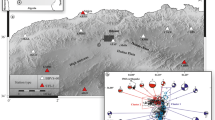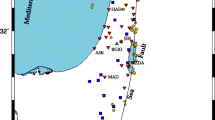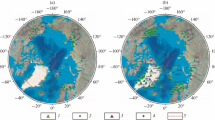Abstract
The instrumental hypocenters of the Liège mainshock on November, 8, 1983, at 0:49 GMT (with macroseismic intensity VII MSK-scale and local magnitude 5.1) and its largest aftershock at 2:13 GMT (magnitude 3.0) have been calculated using weighted arrival times of direct P and S waves from 21 seismic stations in the distance range up to 144 km. A comparison of hypocenter results calculated with various velocity models shows the possibility of determining the epicentral coordinates with a precision of up to ± 1 to 2 km for the best fitting crustal model. The favoured solution for the mainshock is: Origin time 00:49:34.4 GMT, Longitude 5°30.8′ E, Latitude 50°37.9′ N, Depth 6 km. The instrumental epicenter is less than 1 km from the macroseismic epicenter at St.Nicolas.
From digital recordings in West Germany the seismotectonic source parameters of the Liège earthquakes were estimated using S wave displacement spectra of six stations and the Brune source model. In addition, the seismic energy released at the source was calculated from the time integrals of squared ground velocity seismograms. For the mainshock the following values have been found:
-
Seismic Moment MO 1.6 x 1023 dyne cm
-
Source Radius rO 870 m
-
Average Dislocation dO 0.27 m
-
Stress Drop pO 156 bar
-
Seismic Energy ESO 1.3 x 1019 erg
The fault plane solution reveals a strike-slip dislocation, either right-lateral along a plane trending N 71°E, or left-lateral along a plane trending N 167°E. The P-axis is arranged NW-SE and nearly horizontal.
Access this chapter
Tax calculation will be finalised at checkout
Purchases are for personal use only
Preview
Unable to display preview. Download preview PDF.
Similar content being viewed by others
References
Ahorner, L. (1975): Present-day stress field and seismotectonic block movements along major fault zones in Central Europe. - In: Pavoni, N. and Green, R.(eds), Recent Crustal Movements. Tectonophysics 29: 233–249; Amsterdam
Ahorner, L. (1983): Historical seismicity and present-day microearthquake activity of the Rhenish Massif, Central Europe. - In: K.Fuchs et al.(eds.), Plateau Uplift, p. 198–221; Springer-Verlag, Heidelberg
Ahorner, L. (1985): The general pattern of seismotectonic dislocations in Central Europe as a background for the Liège earthquake on November 8, 1983. - (this volume)
Ahorner, L., Baier, B., Bonjer, K.-P. (1983): General pattern of seismotectonic dislocation and the earthquake generating stress field in Central Europe between the Alps and the North Sea. - In: K.Fuchs et al.(eds.), Plateau Uplift, p. 187–197; Springer-Verlag, Heidelberg
Ahorner, L., Pelzing, R. (1983): Seismotektonische Herdparameter von digital registrierten Erdbeben der Jahre 1981 und 1982 in der westlichen Niederrheinischen Bucht. - Geol.Jb. E 26: 35–63; Hannover
Brune, J.N. (1970): Tectonic stress and spectra of seismic shear waves from earthquakes. - J.geophys.Res. 75: 4997–5009; Washington
Crosson, R.S. (1976): Crustal structure modeling of earthquake data. 1. Simultaneous least squares estimations of hypocenter and velocity parameters. - J.geophys.Res. 81: 3036–3046; Washington
Lee, W.H.K., Stewart, S.W. (1981): Principles and applications of microearthquake networks. - 293 p.; Academic-Press, New York
Mechie, J., Prodehl, C., Fuchs, K. (1983): The long range seismic refraction experiment in the Rhenish Massif. - In: K.Fuchs et al. (eds.), Plateau Uplift, p. 260–275; Springer-Verlag, Heidelberg
Mooney, W.D., Prodehl, C. (1978): Crustal structure of the Rhenish Massif and adjacent areas: a reinterpretation of existing seismic refraction data. - J.Geophys. 44: 573–601, Würzburg
Pelzing, R. (1978): Untersuchungen zur Ortung von Herden seismischer Ereignisse, dargestellt an Beispielen aus einem Stationsnetz im Ruhrbergbaugebiet, - Ber.Inst.Geophys.Ruhr-Universität Bochum, 6: 184 p.; Bochum
Richter, C.F. (1958): Elementary Seismology. - 768 p., W.H.Freeman and Comp., San Francisco
Schneider, G. (1975): Erdbeben. Entstehung-Ausbreitung-Wirkung. - 406 p., Enker-Verlag, Stuttgart
Camelbeeck, T., De Becker, M. (1985): The Liège earthquakes of November 8, 1983, and December 21, 1965. - (this volume)
Author information
Authors and Affiliations
Editor information
Editors and Affiliations
Rights and permissions
Copyright information
© 1985 D. Reidel Publishing Company
About this chapter
Cite this chapter
Ahorner, L., Pelzing, R. (1985). The Source Characteristics of the Liège Earthquake on November 8, 1983, From Digital Recordings in West Germany. In: Melchior, P.J. (eds) Seismic Activity in Western Europe. NATO ASI Series, vol 144. Springer, Dordrecht. https://doi.org/10.1007/978-94-009-5273-7_21
Download citation
DOI: https://doi.org/10.1007/978-94-009-5273-7_21
Publisher Name: Springer, Dordrecht
Print ISBN: 978-94-010-8829-9
Online ISBN: 978-94-009-5273-7
eBook Packages: Springer Book Archive




